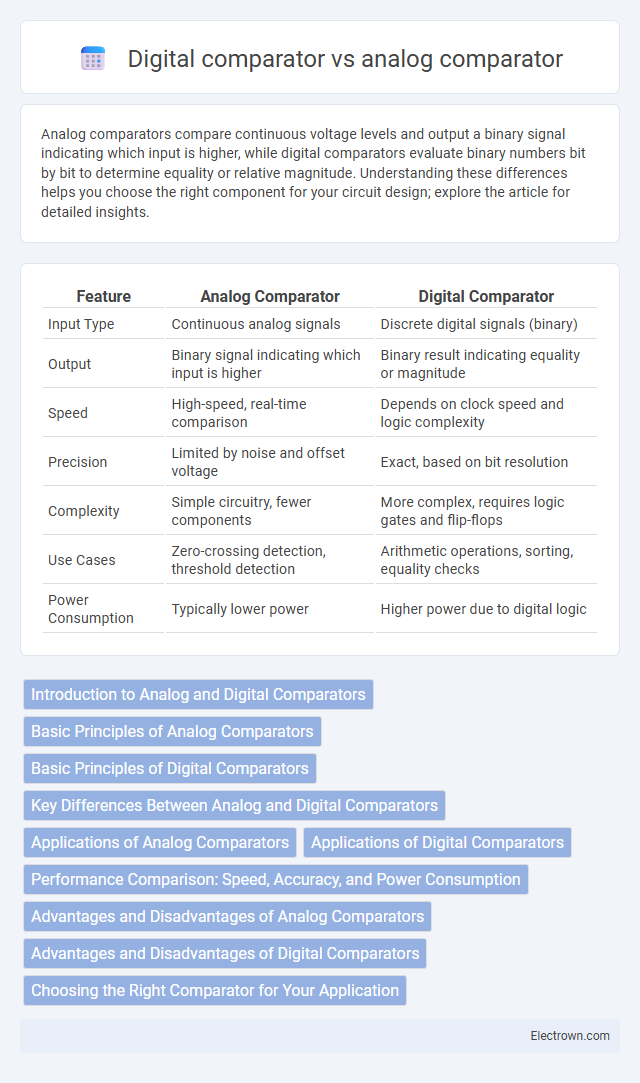Analog comparators compare continuous voltage levels and output a binary signal indicating which input is higher, while digital comparators evaluate binary numbers bit by bit to determine equality or relative magnitude. Understanding these differences helps you choose the right component for your circuit design; explore the article for detailed insights.
Table of Comparison
| Feature | Analog Comparator | Digital Comparator |
|---|---|---|
| Input Type | Continuous analog signals | Discrete digital signals (binary) |
| Output | Binary signal indicating which input is higher | Binary result indicating equality or magnitude |
| Speed | High-speed, real-time comparison | Depends on clock speed and logic complexity |
| Precision | Limited by noise and offset voltage | Exact, based on bit resolution |
| Complexity | Simple circuitry, fewer components | More complex, requires logic gates and flip-flops |
| Use Cases | Zero-crossing detection, threshold detection | Arithmetic operations, sorting, equality checks |
| Power Consumption | Typically lower power | Higher power due to digital logic |
Introduction to Analog and Digital Comparators
Analog comparators measure and compare continuous voltage signals, producing a binary output based on which input is higher, making them essential in signal processing and sensor interfacing. Digital comparators operate on discrete binary values, performing bitwise comparison to determine equality, magnitude, or order between digital words, critical in arithmetic logic units and digital circuits. Understanding the operational difference highlights their roles: analog comparators in real-time analog signal detection and digital comparators in logical decision-making within digital systems.
Basic Principles of Analog Comparators
Analog comparators operate by continuously comparing two input voltages and outputting a signal based on which input is higher, relying on voltage level differences rather than digital states. They use differential amplifier stages to detect small voltage variations, providing real-time, continuous output that reflects analog signal relationships. This sensitivity to subtle voltage changes makes analog comparators essential in applications requiring precise threshold detection and fast response times.
Basic Principles of Digital Comparators
Digital comparators operate by evaluating binary input signals bit by bit to determine equality or order, using combinational logic circuits such as XOR, AND, and OR gates. Unlike analog comparators that compare continuous voltage levels to generate a high or low output, digital comparators work with discrete binary values, enabling precise and noise-immune comparison results. Your choice between analog and digital comparators depends on the application's requirements for accuracy, speed, and compatibility with digital systems.
Key Differences Between Analog and Digital Comparators
Analog comparators continuously compare input voltages and output a binary signal based on which input is higher, making them ideal for real-time threshold detection in analog circuits. Digital comparators process binary data words, comparing bit-by-bit to determine equality or magnitude, essential for digital systems like microprocessors. Your choice depends on whether you need continuous voltage comparison or discrete digital data evaluation.
Applications of Analog Comparators
Analog comparators are widely used in applications requiring real-time signal monitoring such as zero-crossing detectors, overvoltage protection circuits, and pulse-width modulation controllers. They excel in environments where continuous voltage level comparisons are critical for triggering precise analog actions, like battery management systems and temperature sensing. Your choice of an analog comparator ensures fast response times and efficient interfacing with analog signals in embedded and industrial automation systems.
Applications of Digital Comparators
Digital comparators are widely used in microprocessors, digital signal processing, and memory address decoding where precise binary value comparisons are crucial. You'll find them in high-speed arithmetic operations, sorting algorithms, and digital communication systems to ensure accurate data handling and error detection. Their ability to quickly compare multi-bit digital numbers makes them essential components in modern digital electronics and embedded systems.
Performance Comparison: Speed, Accuracy, and Power Consumption
Analog comparators offer faster response times and lower power consumption due to their continuous-time operation, making them ideal for high-speed applications with minimal latency. Digital comparators provide higher accuracy and noise immunity through discrete voltage level processing but typically consume more power and have slower speeds compared to their analog counterparts. Your choice between analog and digital comparators depends on the specific performance requirements, balancing speed, precision, and energy efficiency.
Advantages and Disadvantages of Analog Comparators
Analog comparators offer high-speed operation and consume less power compared to digital comparators, making them ideal for real-time signal processing. They can directly compare continuous voltage levels without requiring conversion to digital values, but they are susceptible to noise and offset errors that affect accuracy. Your choice of an analog comparator should consider these trade-offs between speed, power efficiency, and precision.
Advantages and Disadvantages of Digital Comparators
Digital comparators offer precise and fast decision-making based on binary inputs, enabling accurate equality and magnitude checks between multi-bit numbers in digital circuits. Their advantages include noise immunity, ease of integration with digital systems, and the capability to handle complex comparisons without analog signal distortions. However, digital comparators require more power and silicon area than analog counterparts and may introduce latency in high-speed applications due to digital processing delays.
Choosing the Right Comparator for Your Application
Choosing the right comparator depends on the specific needs of your application, such as signal type, speed, and accuracy requirements. Analog comparators are ideal for continuous voltage monitoring, fast response times, and low power consumption, commonly used in sensor interfaces and waveform detection. Digital comparators excel in discrete logic level comparisons, offering precision, noise immunity, and are preferred in microprocessor and digital circuit applications requiring clear binary outputs.
Analog comparator vs digital comparator Infographic

 electrown.com
electrown.com